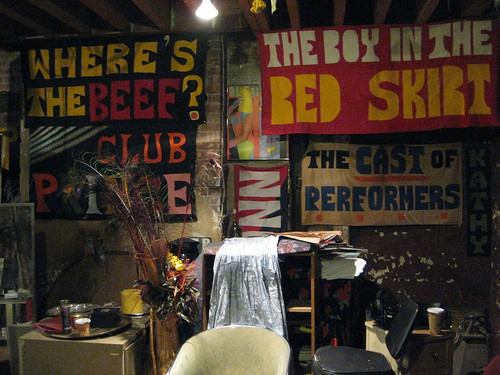Climbing the rickety, makeshift stairway of the century old former tenement building on East Third Street that houses the Nuyorican Poets Café there was little to foretell the treasure trove Kim Davis and I would encounter. Daniel Gallant, executive director of the Nuyorican, explained that few know of the existence of the archives we were set to explore, and even fewer got to view this lofty realm as the Café has no certificate of occupancy for the top three floors of the building, which are not open to the public and are used strictly for storage. Daniel described how poet Miguel Algarín, and the Café’s other founders, had acquired the building from LaMama Theater creator Ellen Stewart in 1980 and established a venue where Lower East Side poets, playwrights and musicians could present their work.
After Daniel unlocked the padlock fastened to a small piece of plywood serving as a makeshift door leading to the third floor, we crouched to squeeze through the narrow entryway. As we ascended the stairs, the exposed brick walls were crowded with posters, paintings and costume designs from former productions held in the performance space occupying the first two floors of the building. Reaching the top of the stairs we entered a dimly lit, open loft space crammed in virtual disarray with a treasure trove of costumes crowded on racks, stage props, banners, posters and a vast collection of bric-a-brac accumulated over more than thirty years.
Costume designers have borrowed some of these period outfits for use in recent films. A large sign for one of the Nuyorican’s landmark productions, “Julius Caesar Set in Africa,” hung on the wall. As we wandered about the floor, it was difficult to appreciate everything. Exposed brick walls, fireplace mantles, thick wooden rafter beams were the only remains of the former railroad apartments that had existed in the building’s former tenement incarnation.
Dan regaled us with the history of numerous Nuyorican productions which had their sets and costumes created in this space. Tony Award winning playwright and actor Sarah Jones began her career with her first solo show, “Surface Transit” at the Nuyorican in 1998. She recently returned for a two week engagement after a Broadway run of “Bridge and Tunnel.” A sewing machine, paint cans, bolts of fabric, containers holding glitter, jars full of buttons, rolls of yarn and thread were evidence of the many hours that artists and writers like Sarah Jones “Bridge and Tunnel” and Miguel Piñero (“Short Eyes”) labored in the space.
The standing-room-only crowds drawn to poetry slams, theater performances and other events at the Nuyorican have created the need for an additional performance space. The Café has already raised a half million dollars of an estimated two to three million dollars required to renovate the upper floors to create a second performance space, along with classrooms. Dan proudly told us that as soon as this new space is completed it would immediately be fully booked for the following year. The creation of this new space has precipitated the need to decide what to do with this vast archive.
We climbed another flight of stairs to the fourth floor where the walls were lined with piles of cartons containing book galleys, small press poetry books by poets who had read at the Café, sound recordings of readings and productions, poetry manuscripts, and the original scripts from the “Fifth Night” series of readings, some of which were produced as movies. Only a small portion of the papers and records have been digitized; the bulk of the materials have yet to be examined or inventoried. Paintings, cardboard posters, banners covered the brick walls and hung from the wooden rafters. Rumor has it that a Basquiat painting or two are buried amongst one of the piles, a leftover from the days when he was a frequent visitor to the Nuyorican.
Various possibilities exist for finding a new home for the archives. Exit Art, another alternative arts space has expressed an interest in acquiring the collection. NYU’s Fales Library, with its Downtown Collection, might seem a natural repository for such a valued record of East Village performance arts. Dan mentioned The New York Public Library for the Performing Arts at Lincoln Center as another possible destination. As Lower East Side grassroots organizations like the Nuyorican gradually institutionalize, the materials they’ve collected become the treasured sources for future historians.
Finally, we climbed up to the fifth floor of the building which has been scaled back to only half the length of the lower floors. As we stepped out onto the rooftop and gazed out over the expanse of rooftops, Daniel imagined the new performance space that would one day occupy this floor. Until then, be sure to check out the Nuyorican website and head over to the Café to become part of such a venerable history.
Created with Admarket’s flickrSLiDR
Did you know about the archive at the Nuyorican? If you worked there and have any knowledge of the materials on those upper floors, we’d love to hear from you (the Nuyorican would too).




